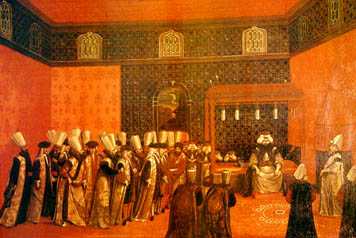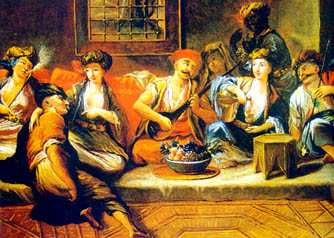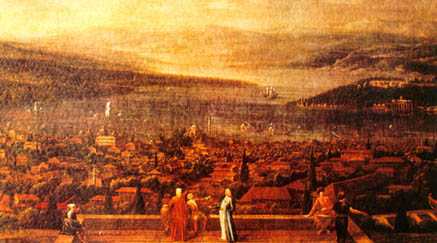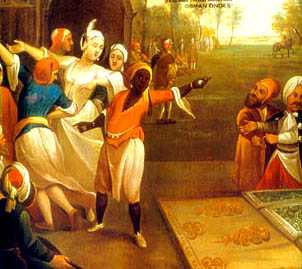Jean-Baptiste Van Mour
 The second
half of the reign of Ahmed III (1703-1730), who was deposed in the
Patrona Halil uprising, is known as the Tulip Era. This was a
time when love of worldly pleasures and the arts went hand in hand, and might be described
as the Ottoman renaissance in architecture, painting and poetry. The gardens of Istanbul
were bedecked with tulips, a passionate love of which began with Grand Vezir Nevşehirli Damat İbrahim Paşa. This was a time when the court
and families of high-ranking state officials in the capital Istanbul built graceful
pavilions, mansions and waterfront houses with beautifully laid out gardens. In spring
these beautiful flowers transformed the city into a riot of colour. Tulip growing became
so popular that hundreds of new varieties were cultivated, as we learn from contemporary
records. The second
half of the reign of Ahmed III (1703-1730), who was deposed in the
Patrona Halil uprising, is known as the Tulip Era. This was a
time when love of worldly pleasures and the arts went hand in hand, and might be described
as the Ottoman renaissance in architecture, painting and poetry. The gardens of Istanbul
were bedecked with tulips, a passionate love of which began with Grand Vezir Nevşehirli Damat İbrahim Paşa. This was a time when the court
and families of high-ranking state officials in the capital Istanbul built graceful
pavilions, mansions and waterfront houses with beautifully laid out gardens. In spring
these beautiful flowers transformed the city into a riot of colour. Tulip growing became
so popular that hundreds of new varieties were cultivated, as we learn from contemporary
records.
But while the upper classes were preoccupied with their tulips, the common people were
suffering unprecedented poverty, and discontent finally erupted in a rebellion led by
Patrona Halil. Nevşehirli İbrahim Paşa was killed and Ahmed III deposed. Not content
with that, the pavilions and mansions were demolished to erase all traces of the Tulip
Era.
 The Dutch
painter Jean-Baptiste Van Mour was witness to both the Tulip Era and its aftermath. He
lived in Istanbul for 37 years, and is known to have been buried next to Baron de Salagnac
in the graveyard of the Jesuit Church of St Louis on Nuru Ziya Sokak in the district of
Galata.However, there is no trace of his grave there today. Whether no stone was placed to
mark it, or there was a stone which later disappeared is unknown. The Dutch
painter Jean-Baptiste Van Mour was witness to both the Tulip Era and its aftermath. He
lived in Istanbul for 37 years, and is known to have been buried next to Baron de Salagnac
in the graveyard of the Jesuit Church of St Louis on Nuru Ziya Sokak in the district of
Galata.However, there is no trace of his grave there today. Whether no stone was placed to
mark it, or there was a stone which later disappeared is unknown.
Van Mour is best remembered for his paintings depicting court life. His work was
admired by Ahmed III, and as a result of this royal favour Van Mour was able to execute
many portraits of courtiers during his years in Istanbul. He enjoyed equal fame among
Europe's diplomatic community in Istanbul.
 Van Mour
was born in the Flemish city of Valenciennes in northern France on 9 January 1671. He
studied art in the studio of Jacques-Albert Gérin, and his work attracted the attention
of an aristocrat and statesman of the time, Marquis Charles de Ferriol.
Ferriol became Van Mour's patron, and when the marquis was appointed ambassador to
Istanbul in 1699 he took Van Mour with him. In Istanbul Van Mour devoted himself to
drawing the people and sights of the city, and when Ferriol returned to Paris in 1712, he
took with him a huge collection of engravings, including a hundred portraits of Ottoman
figures executed by Van Mour between 1707 and 1708. He had these published in an album,
which readily sold to an eager public and was reprinted twice. The album's fame spread all
over Europe and spawned numerous copies and imitations during the 18th century. Van Mour
was born in the Flemish city of Valenciennes in northern France on 9 January 1671. He
studied art in the studio of Jacques-Albert Gérin, and his work attracted the attention
of an aristocrat and statesman of the time, Marquis Charles de Ferriol.
Ferriol became Van Mour's patron, and when the marquis was appointed ambassador to
Istanbul in 1699 he took Van Mour with him. In Istanbul Van Mour devoted himself to
drawing the people and sights of the city, and when Ferriol returned to Paris in 1712, he
took with him a huge collection of engravings, including a hundred portraits of Ottoman
figures executed by Van Mour between 1707 and 1708. He had these published in an album,
which readily sold to an eager public and was reprinted twice. The album's fame spread all
over Europe and spawned numerous copies and imitations during the 18th century.
 Van Mour
did not return to Paris with Ferriol, but remained in Istanbul. In 1725, thanks to the
recommendation of Marquis de Bonnac Van Mour was awarded the title of peintre
ordinaire du Roi en Levant, but this did not prevent him falling increasingly into
financial difficulties. The Dutch ambassador Cornelis Calkoen, a great admirer of Van
Mour's work, came to the rescue and took Van Mour under his patronage. Van Mour
did not return to Paris with Ferriol, but remained in Istanbul. In 1725, thanks to the
recommendation of Marquis de Bonnac Van Mour was awarded the title of peintre
ordinaire du Roi en Levant, but this did not prevent him falling increasingly into
financial difficulties. The Dutch ambassador Cornelis Calkoen, a great admirer of Van
Mour's work, came to the rescue and took Van Mour under his patronage.
This painter who immortalised the Tulip Era and lived through the terrifying Patrona
Halil rebellion which brought the era to an end, died in his adopted city in 1737. His
former patron Cornelis Calkoen had a large collection of paintings by Van Mour, and in his
will of 1762 forbade his heirs to sell these paintings or break up the collection. In the
event of his descendants dying without heir, the will directed that the paintings were to
be given to the Directorat du Commerce au Levant in Amsterdam. Referred to as the
Turkish paintings, the Van Mour collection came into the hands of this institution in
1817. When the directorate was closed down in 1827, the Van Mour collection became the
property of the state, and was placed in the Cabinet Royal de Raretés in The Hague. Since
1903 the collection has been in the Rijksmuseum.
- Source:
- Jean-Baptiste Van Mour
- By Osman Öndeş
SKYLIFE 06/2000
|